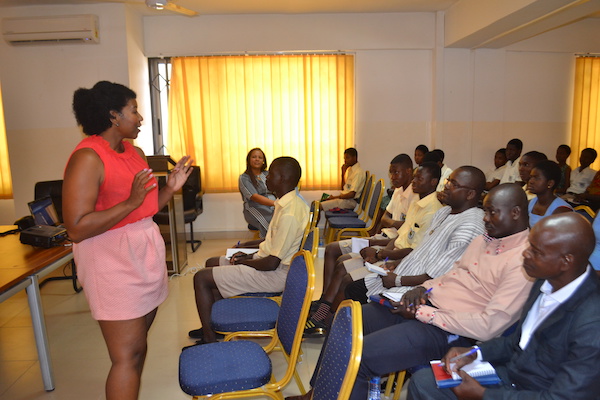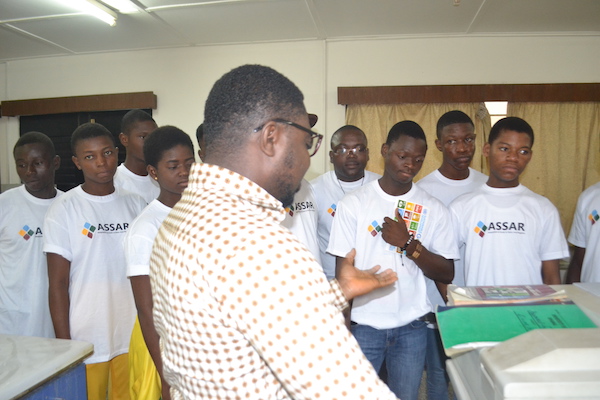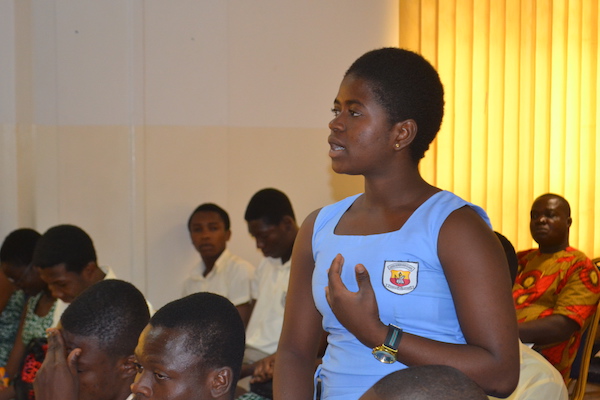By Prosper Adiku, Rahinatu Sidiki Alare and Wendy Boakye
On May 13-16 2018, the winners of the Climate Change Adaptation Through Youth Innovation (CATYI) competition paid a visit to the Institute for Environment and Sanitation Studies (IESS) of the University of Ghana. The visit formed part of the award for the CATYI competition held among selected Senior High Schools in the Lawra and Nandom districts of the Upper West Region on January 20. The visiting teams included five students from the Nandom and Lawra Senior High schools who won the first and second positions respectively, team supervisors and the local coordinator of the competition.
Hosted by the Ghana Team of the Adaptation at Scale in Semi-Arid Regions (ASSAR) program, the first day activities included a welcome address from the Director of the Institute, Prof. Chris Gordon, introduction to the Institute and the University at large and series of presentations from invited guests. The chief executives of youth-led environmental organizations; Greener Impact International (GII) and Environment360 gave inspiring presentations emphasizing existing opportunities requiring youth action in the country.

The students also used the opportunity to share their award winning ideas with colleague students, mainly environmental club members from the Achimota Senior High School in Accra. On a tour of the University Campus, the students visited some Departments, Centres and ongoing project units including the Marine and Fisheries Sciences Department, Monitoring Environment for Security in Africa (MESA), Centre for Remote Sensing and Geographic Information Systems (CERGIS) among others.
The teams also visited coastal Accra, specifically Jamestown, a dominant fishing community with a lighthouse and the James fort, originally used as a slave post and later as a prison. The Jamestown visit helped the students appreciate the differences in livelihood activities as well as the dynamic nature of climatic and non-climatic stressors of coastal compared to semi-arid regions.

Students and supervisors were impressed by ASSAR’s efforts, particularly with respect to the involvement of the students through the introduction of the CATYI competition. Mr. Jacob Dumba, a tutor of the Lawra Senior High school is convinced that the students have “learnt so much about the environment and climate change through the competition” and is of the firm view that establishing more environmental clubs in the schools will enhance students’ knowledge on environmental issues. Through the competition the students were encouraged and motivated to take action in their own capacities towards the environment. Maaku Samson of the Lawra Senior High School is poised for action and said: “I will encourage people and let them know that we don’t have to wait for someone to motivate us or give us something to protect our environment but we have to work hard to promote the quality of nature”. Mohammed Ibrahim of the Nandom Senior High School was grateful for the opportunity and said that he learnt that “you can’t be a good innovator if you don’t want to try”.

Way forward
The interactions with Greener Impact might provide the opportunity for CATYI students to participate in future youth-related activities of the organization, particularly in future Ghana Youth Conference on Climate Change and Sustainable Development (GYCCCSD) activities. The team is also exploring the possibility of creating an online platform in the schools for exchanging knowledge on climate change and for strengthening existing environmental clubs in the area.
The CATYI Competition was implemented as part of the Small Opportunities Grant (SOG) Award received under the Adaptation at Scale in Semi-Arid Regions (ASSAR) Program. The SOGs are in recognition of the need to go beyond academic capacity building within ASSAR to do more to strengthen the capacities of those living and working in the ASSAR study sites.


